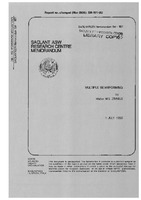| dc.contributor.author | Zimmer, Walter M. X. | |
| dc.date.accessioned | 2018-10-11T14:05:49Z | |
| dc.date.available | 2018-10-11T14:05:49Z | |
| dc.date.issued | 1985/07 | |
| dc.identifier | 1659 | |
| dc.identifier.govdoc | SM-181 | |
| dc.identifier.uri | http://hdl.handle.net/20.500.12489/152 | |
| dc.description.abstract | Beamforming techniques are generally based on the assumption that the received signal arrives from | |
| dc.description.abstract | a single source. In a realistic situation, however, there is more than one source present and these | |
| dc.description.abstract | sources can interact with each other in the beamformer. This paper describes a multiple beamformer | |
| dc.description.abstract | in which the interaction of different sources is included in the algorithm. The maximum likelihood | |
| dc.description.abstract | principle is used to find the different source amplitude and bearing estimates. The performance of the algorithm is compared for varying conditions with the Cramer-Rao lower bound. Two pre-processors | |
| dc.description.abstract | necessary and suitable to ensure globally optimized results are derived from the ideas of Pisarenko | |
| dc.description.abstract | and Prony. Finally, a post-processor is proposed to evaluate the success of the multiple beamformer. | |
| dc.format | 24 p. : ill. ; 5 fig. | |
| dc.language | English | |
| dc.publisher | NATO. SACLANTCEN | |
| dc.relation.ispartofseries | ADA159979 | |
| dc.subject | Signal processing | |
| dc.subject | Beamforming | |
| dc.title | Multiple beamforming | |
| dc.type | Scientific Memorandum (SM) | |
